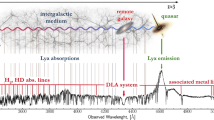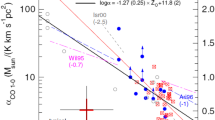Abstract
In the last years, progress has been very rapid in the domain of molecules at high redshift, and we know in better detail now the molecular content in several systems beyond z = 1 and up to z~ 5, either through millimeter and sub-millimeter emission lines, continuum dust emission, or millimeter absorption lines in front of quasars. The first discovery in 1992 by Brown and van den Bout of CO lines at z = 2.28 in a gravitationally lensed starburst galaxy, strongly stimulated searches of other systems, but these were harder than foreseen, and less than 10 other systems have been discovered in CO emission. Redshifts range between 2 and 5, the largest being BR1202-0725 at z = 4.69. Most of these systems, if not all, are gravitationally amplified objects. Some have been discovered first through their dust emission, relatively easy to detect because of the negative K-correction effect. The detection of all these systems could give an answer about the debated question of the star-formation rate as a function of redshift. The maximum of star-formation rate, found around z = 2 from optical studies, could shift to higher z if the most remote objects are hidden by dust.
Absorption in front of quasars can also probe cold gas at high redshift, taking advantage of very high spatial (≤ 10-3 arcsec) and spectral (30m/s) resolutions, and sampling column-densities between N(H2)= 1020 and 1024 cm-2. Up to now four absorption systems have been discovered in the millimeter range, and up to 20 molecular lines have been detected in a single object (HCO+, HNC, HCN, N2H+, C18O, CS, H2 CO, CN, etc....). From the diffuse components, one can measure the cosmic black body temperature as a function of redshift. The high column density component allows observation of important molecules not detectable from the ground, like O2, H2O and LiH for example.
All these preliminary studies will be carried out at large scales with future millimeter instruments, and some perspectives are given.
Access this chapter
Tax calculation will be finalised at checkout
Purchases are for personal use only
Preview
Unable to display preview. Download preview PDF.
Similar content being viewed by others
References
Barger A.J., Cowie L.L., Sanders D.B. et al.: 1998, Nature 394, 248
Barvainis R., Alloin D., Guilloteau S., Antonucci R. 1998, ApJ 492, L13
Barvainis R., Tacconi L., Antonucci R., Coleman P.: 1994, Nature 371, 586
Blain A.W., Longair M.S.: 1993, MNRAS 264, 509
Brown R., Vanden Bout P.: 1992, ApJ 397, L19
Brown R., Vanden Bout P.: 1991, AJ 102, 1956
Carilli C.L., Perlman E.S., Stocke J.T.: 1992, ApJ 400, L13
Carilli, C.L., Rupen, M.P., Yanny, B. 1993, ApJ 412, L59
Carilli, C.L., Menten K.M., Reid M.J., Rupen, M.P., Yun M.S.: 1998, ApJ 494, 175
Chengalur J.N., de Bruyn A.G., Narasimha D.: 1999, A&A in press
Combes F., Wiklind T., Nakai N.: 1997, A&A 327, L17
Combes F., Wiklind T.: 1996, in “Cold gas at high redshift”, ed. Bremer M., Rottgering H., van der Werf P., Carilli C.L. (Dordrecht:Kluwer), p. 215
Combes F., Wiklind T.: 1997, ApJ 486, L79
Combes F., Wiklind T.: 1998, A&A 334, L81
Combes F., Maoli R., Omont M.: 1999, A&A in press
Downes D., Neri R., Wiklind T., Wilner D.J., Shaver P.: 1998, ApJ preprint (astroph/9810111)
Downes D., Solomon P.M., Radford S.J.E. 1995, ApJ 453, L65
Drinkwater, M. J., Webb, J. K., Barrow, J. D., Flambaum, V. V.: 1998, MNRAS 295, 457
Eales S.A., Lilly S.J., Gear W.K., Dunne L., Bond J.R., Hammer F., Le Fevre O., Crampton D.: 1999, ApJL in press (astro-ph/9808040)
Flores H., Hammer F., Thuan X. et al.: 1999, ApJ in press (astro-ph/9811202)
Frayer D.T., Ivison R.J., Scoville N.Z., et al., 1998, ApJ 506, L7
Ge J., Bechtold J., Black J.: 1997, ApJ 474, 67
Guilloteau S., Omont A., McMahon R.G., Cox P., Petit-Jean P.: 1997, A&A 328, L1
Hauser M.G., Arendt R.G., Kelsall T., et al.: 1998, ApJ 508, 25
Hughes D.H., Serjeant S., Dunlop J. et al.: 1998, Nature 394, 241
Lo K.Y., Chen H-W., Ho P.T.P.: 1999, A&A 341, 348
Lu, L., Sargent, W. L. W., Womble, D. S., Barlow, T. A.: 1996, ApJ, 457, L1
Mather, J. C., et al.: 1994, ApJ, 420, 439
Ohta K., Yamada T., Nakanishi K., Kohno K., Akiyama M., Kawabe R.: 1996, Nature 382, 426
Omont A., Petitjean P., Guilloteau S., McMahon R.G., Solomon P.M.: 1996, Nature 382, 428
Puget J.L., Abergel A., Bernard J-P. et al.: 1996, A&A 308, L5
Richards E.R.: 1998, ApJ in press (astro-ph/9811098)
Scoville N.Z., Padin S., Sanders DB et al.: 1993, ApJ 415, L75
Scoville N.Z., Yun M.S., Windhorst R.A., Keel W.C., Armus L.: 1997, ApJ 485, L21
Smail I., Ivison R.J., Blain A.W.: 1997, ApJL 490, L5
Solomon P.M., Downes D., Radford S.J.E., Barrett J.W.: 1997, ApJ 478, 144
Solomon P.M., Downes D., Radford S.J.E.: 1992, Nature 356, 318
Songaila, A., Cowie L.L., Hogan C., Rugers M.: 1994a: Nature, 368, 599
Songaila, A., Cowie L.L., Vogt S. et al.: 1994b: Nature, 371, 43
Yum M.S., Scoville N.Z.: 1998, ApJ 507, 774
Wiklind T., Combes F.: 1994, A&A 286, L9
Wiklind T., Combes F.: 1995, A&A 299, 382
Wiklind T., Combes F.: 1996, Nature 379, 139
Wiklind T., Combes F.: 1997, A&A 328, 48
Wiklind T., Combes F.: 1998, ApJ 500, 129
Wink J.E., Guilloteau S., Wilson T.L.; 1997, A&A 322, 427
Author information
Authors and Affiliations
Editor information
Editors and Affiliations
Rights and permissions
Copyright information
© 1999 Springer-Verlag Berlin Heidelberg
About this paper
Cite this paper
Combes, F. (1999). Dust and Molecules at High Redshift. In: Walsh, J.R., Rosa, M.R. (eds) Chemical Evolution from Zero to High Redshift. ESO Astrophysics Symposia. Springer, Berlin, Heidelberg. https://doi.org/10.1007/978-3-540-48360-1_49
Download citation
DOI: https://doi.org/10.1007/978-3-540-48360-1_49
Publisher Name: Springer, Berlin, Heidelberg
Print ISBN: 978-3-662-21697-2
Online ISBN: 978-3-540-48360-1
eBook Packages: Springer Book Archive




